
sunchoau - 5-12-2016 at 20:21
Workers today found the rock?? as shown in the attached photos on the side of the road.
It is a dark blue green colour with an amber sheen..
It is fibrous in nature with one end appearing denser than the other. It is quite porous.
Any ideas as to what this may be???
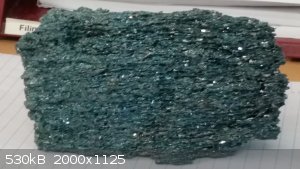
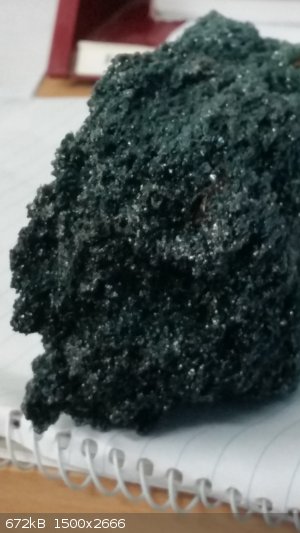
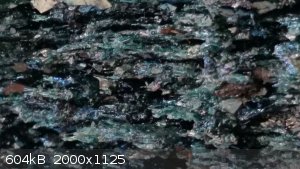
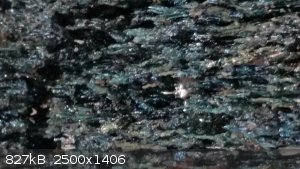
violet sin - 5-12-2016 at 20:34
Looks just like a sample of silicon carbide I bought on saturday.
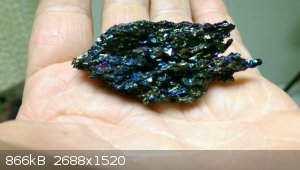
Does it scratch glass like mine? I should add, the guy whom sold me that bit had several others that were similar but finer, thicker, more open and
almost closed up varietys. Grabbed a small well crystalized bit of the litter.
He always hooks me up with random rocks so as to spread the wealth, and I almost never leave having spent less than $5. A small price to pay for
some of the deals received over the years. If memory serves, one time he mentioned the material was man made.
[Edited on 6-12-2016 by violet sin]
diddi - 6-12-2016 at 03:21
it looks like a micacious schist to me?
yes silicon carbide is man made. it often appears on ebay from chinese sellers as "natural" silicon stone or some such name. but it is entirely
unnatural
[Edited on 6-12-2016 by diddi]
crystal grower - 6-12-2016 at 08:42
I regognised it as SiC at the first sight too. To confirm it, test if it can scratch the glass as Violent sin said.
Im quite curious about origins of this piece, because silicon carbide is produced by reaction of Si/SiO2 with carbon at temp. Cca 1800-1900C if memory
serves me well. Naturally it occurs as mineral moissanite, which was found only in meteorites.
sunchoau - 6-12-2016 at 14:36
Many Thanks for the replies.
The "rock" does indeed scratch glass...in fact it is a very good glass cutter....
The general feel, from the discussion, is that is man made silicon carbide.
This piece is around 130mm long and around 60 x60 mm wide and deep.
It bears no impact marks and must have been cool or cold when deposited to where it was found....
How it got there is a mystery, however, I believe, its identity is solved.
Again,
Many Thanks for the replies.
Eddygp - 7-12-2016 at 05:36
The fact that it scratches glass does not tell us what it is immediately, especially since SiC is man-made.
Otherwise, with the same arguments you could be holding a huge lump of black diamond or sapphire.
crystal grower - 7-12-2016 at 05:58
I agree that the fact it scratches glass isn't enough evidence to prove it's SiC. However, it visually looks very similiar to silicon carbide and I
haven't ever seen samples of diamond, corund or other hard minerals with such habitus.
Edit: what may be a case is that it could be for example titanium carbide or some other carbide or maybe some boride.
Anyway its most likely a manmade comound IMO.
(I would be glad to find out it's a mineral though  ).
).
[Edited on 7-12-2016 by crystal grower]
[Edited on 7-12-2016 by crystal grower]
Bert - 7-12-2016 at 07:49
This close up is cool. Those little clusters of what looks like quartz crystals, interspersed with the dark, ?carbide?...
Got anything else harder to test harness against, does it scatch a porcelain streak plate too? How dense...
And is there an abbrasives factory around that area? Odd thing to find in the wild.
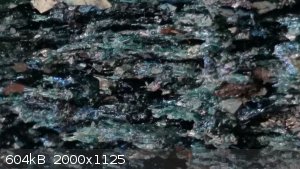
crystal grower - 7-12-2016 at 08:57
Those crystals may be SiC too. I have similiar sample with small hexagonal crystals in it too. SiC forms 3polymorphs, two of them hexagonal(formed at
>1700C) and the last one cubic (formed at lower temp.).
If you have a piece of corund (Al2O3) (sorry if I want much from you  ) you can
try to scratch it with this sample, silicon carbide is really hard -about 9.5 in mohs scale.
) you can
try to scratch it with this sample, silicon carbide is really hard -about 9.5 in mohs scale.
[Edited on 7-12-2016 by crystal grower]
AJKOER - 3-1-2017 at 10:46
I saw a similar rock in a science museum with the bubbles and texture of your mystery rock.
It was presented as a sample of volcanic rock.
So, assuming a lava flow containing hot Si/SiO2 comes into contact with a tree (a source of carbon and CO), the product could be some superficial SiC.
Generally, however, lava is under 1,250 C and may not be hot enough, so the option of an artificial electric furnace formation is still more likely.
Per Wikipedia on SiC (https://en.m.wikipedia.org/wiki/Silicon_carbide ), it is not likely moissanite, as that is an extremely rare mineral.
[Edited on 4-1-2017 by AJKOER]
Magnetic?
explosive eddy - 4-1-2017 at 21:45
I found a rock similar to this once it was greenish and porous. Whenever I tested it with a magnet it stuck strongly. My theory is it was a iron
meteorite that hit water when it was really hot. I found it next to water and it had quite a few fractures that were clean cut for a rock. Have you
tested to see if it is magnetic?
diddi - 5-1-2017 at 01:04
it is definitely not a meteorite. I collect them
bolbol - 26-1-2017 at 13:19
What locality did you collect this from? It would help to identify what it might be.
Maroboduus - 26-1-2017 at 14:27
Looks an awful lot like some coarse varieties of pumice I've seen.
At least some pumice does in fact scratch glass.

 ).
). ) you can
try to scratch it with this sample, silicon carbide is really hard -about 9.5 in mohs scale.
) you can
try to scratch it with this sample, silicon carbide is really hard -about 9.5 in mohs scale.